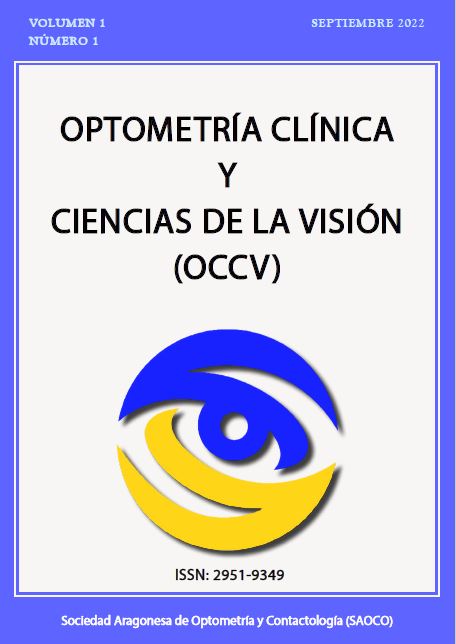Influence of Global Motion Perception on Reading
Main Article Content
Abstract
Purpose: To determine the association between global motion perception and reading speed in healthy children aged 7 to 9 years.
Methods: A total of 26 participants were included, of whom 57.7% were female. Subjects with normal binocular vision and a decimal visual acuity greater than 0.90 for near vision were included. Participants with a diagnosis of dyslexia were excluded. The study was conducted by the same professional, in the same school where the patients were located, on an individualized basis, with an approximate duration of 30 minutes per patient.
Results: The results showed that global motion perception was correlated with reading speed, mainly when motion sensitivity was measured with a high number of coherent points (40%). However, reading speed was also associated with poor visual discrimination and the efficiency of saccadic movements necessary for reading. Additionally, the greater the coherence of points, the greater the correlation with visual discrimination and the deficiency of saccadic movements.
Conclusions: Our findings support the hypothesis that global motion perception, although to a lesser extent than visual discrimination, is associated with reading speed.
Article Details

This work is licensed under a Creative Commons Attribution-NonCommercial 4.0 International License.
How to Cite
References
Goldstand S, Koslowe KC, Parush S. Vision,Visual-Information Processing, and Academic Performance Among Seventh-GradeSchoolchildren: ¿A More Significant Relationship Than We Thought? Am J Occup Ther. 2005;59(4):377-89.
Díaz Álvarez S, Gómez García A, Jiménez Garófano C, Martínez Jiménez MP. Bases optométricas para una lectura eficaz. Madrid,Trabajo de Fin de Master del COI, 2004.
Sánchez Delgado, P. PISA 2012. Programa para la evaluación internacional de los alumnos. Informe español. Resultados y contexto. Reseña. Revista de Educacion 365 244 246.
Hussaindeen JR, Shah P, Ramani KK, Ramanujanc L. Efficacy of vision therapy in children with learning disability and associated binocular vision anomalies. J Optom. 2018 Jan-Mar; 11(1): 40–48. doi: 10.1016/j.optom.2017.02.002.
Cestnick L, Coltheart M. The relationship between language and visual processing indevelopmental dyslexics. Cognition 1999; 71: 231-55.
Galaburda A, Livingstone M. Evidence for a magnocellular defect in developmental dyslexia. Ann N Y Acad Sci 1993; 682: 70-82.
Galaburda AM, Cestnick L. Dislexia del desarrollo. S9REV NEUROL 2003; 36 (Supl 1):S3-S9.
Ratey, JJ. El cerebro: manual de instrucciones. Grupo Editorial Random House.
Soriano Mas, C. Fundamentos de neurociencia. Barcelona: editorial UOC; 2007.
Guyton, AC. Anatomía y fisiología del sistema nervioso. Neurocienciabásica. 2ªedición. Madrid: editorial medica panamericana; 1997.
Santiesteban Freixas, R. Oftalmología pediátrica. La Habana: editorial Ciencias Médicas;2010.
Schünke M, Schulte E, Schumacher U, VollM, Wesker K. Prometheus. Texto y atlas de anatomía. Tomo 3. Cabeza y Neuroanatomía 2ª mejorada y ampliada. ed. Madrid: Editorial Médica Panamericana;2010.
Carpenter, MB. Neuroanatomía: Fundamentos. 4ª edición. Madrid: Editorial medica panamericana; 1994.
Livingstone MS, Hubel D. Segregation of form, colour, movement anddepth: anatomy and perception. Science. 1988;240:740-749.
Gori S, Seitz AR, Ronconi L, Franceschini S, Facoetti A. Multiple Causal Links Between Magnocellular–Dorsal Pathway Deficit and Developmental Dyslexia. Cereb Cortex. 2016;26(11):4356-4369.
Braddick O, O'Brien J, Wattam-Bell J, Atkinson J, Hartley T, Turner, R. Brain Areas Sensitive to Coherent Visual Motion. Perception. 2001;30:61-72.
Heutink J, de Haan G, Marsman JB, van Dijk M, Cordes C. The effect of target speed on perception of visual motion directionin a patient with akinetopsia. Cortex 2019;119:511-518.
Skalicky, SE. Neural Control of Eye Movements. Ocular and Visual Physiology 2016;251-270.
Wallot S, O'Brien BA, Haussmann A, Kloos H, Lyby MS. The role of reading time complexity and reading speed in text comprehension. J Exp Psychol Learn Mem Cogn. 2014;40(6):1745-65. doi: 10.1037/xlm0000030.
Stein, J. Visual motion sensitivity and reading. Neuropsychologia. 2003;41(13):1785-93.
Hayward J, Truong G, Partanen M, Giaschi D. Effects of speed, age, and amblyopia on the perception of motion-defined form. Vision Research- 2011;51:2216–2234.
Badcock DR, Clifford CWG, Khuu SK. Interactions between luminance and contrast signals in global form detection. Vision Research 2005;45, 881–889.
Braddick O, Qian N. The organization of global motion and transparency. Motion vision—computational, neural and ecological constraints. 2001:86–106. Berlin: Springer.
Ellemberg D, Lewis TL, Dirks M, Maurer D, Ledgeway T, Guillemot JP et al. Putting order into the development of sensitivity to global motion. Vision Research, 2004;44, 2403–2411.
Braddick O, Atkinson J, Wattam-Bell J. Normal and anomalous development of visual motion processing: motion coherence and ‘dorsal stream vulnerability’. Neuropsychologia 2003;41(13), 1769–1784.
Tassinari JT, De Land P. Developmental Eye Movement Test: reliability and symptomatology. Optometry 2005;76:387-99.
Orlansky, Gale, y otros. Reliability of theDevelopmental Eye Movement Test. Optometry and Vision Science: December 2011;88(12):1507-1519.
Breitmeyer BG, Ganz L. Implications of Sustained and Transient Channels for Theories of Visual Pattern Masking, Saccadic Suppression, and Information Processing. Psychol Rev. 1976;83(1):1-36.
Lovegrove W.J, Bowling A, Badcock D, Blackwood M. Specific reading disability: Differences in Contrast Sensitivity as a Function of Spatial Frequency. Science 1980;210:439–440.
Demb JB, Boynton GM, Heeger DJ. Brain activity in visual cortex predicts individual differences in reading performance. Proc. Natl. Acad. Sci. USA 1997;94:13363–13366.
Talcott JB, Hansen PC, Assoku EL, Stein JF. Visual motion sensitivity in dyslexia: Evidence for temporal and energy integration deficits. Neuropsychologia 2000;38, 935–943.
Boets B, Vandermosten M, Cornelissen P, Wouters J, Ghesquière P. Coherent Motion Sensitivity and Reading Development in the Transition From Prereading to Reading Stage. Child Dev 2011;82:854–869.
Eden GF, VanMeter JW, Rumsey JM, Maisog JM, Woods RP, Zeffiro TA. Abnormal processing of visual motion in dyslexia revealed by functional brain imaging. Nature 1996;382, 66–69.
Ben-Shachar M, Dougherty RF, Deutsch GK, Wandell BA. Contrast responsivity in MT+ correlates with phonological awareness and reading measures in children. Neuroimage 2007;37: 1396–1406.
Cornelissen P, Richardson A, Mason A, Fowler S, Stein J. Contrast sensitivity and coherent motion detection measured at photopic luminance levels in dyslexics and controls. Vision Res 1995;35:1483–1494.
Bowman, MD. Learning disabilities, dyslexia, and vision: a subject review--a rebuttal, literature review, and commentary. Optometry. 2002;73(9):553-75.
Joo SJ, Donnelly PM, Yeatman JD. The causal relationship between dyslexia and motion perception reconsidered. Sci Rep. 2017;7:4185.
Kassaliete E, Lacis L, Fomins S. Reading and coherent motion perception in school age. Ann Dyslexia 2015 Jul;65(2):69-83.
Pennington, BF. From single to multiple deficit models of developmental disorders. Cognition 1006;101:385–413

